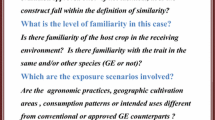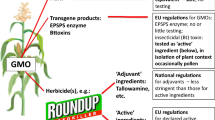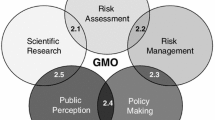Abstract
In many countries there are increasing calls for the benefits of genetically modified organisms (GMOs) to be considered as well as the risks, and for a risk-benefit analysis to form an integral part of GMO regulatory frameworks. This trend represents a shift away from the strict emphasis on risks, which is encapsulated in the Precautionary Principle that forms the basis for the Cartagena Protocol on Biosafety, and which is reflected in the national legislation of many countries. The introduction of risk-benefit analysis of GMOs would be facilitated if clear methodologies were available to support the analysis. Up to now, methodologies for risk-benefit analysis that would be applicable to the introduction of GMOs have not been well defined. This paper describes a relatively simple semi-quantitative methodology that could be easily applied as a decision support tool, giving particular consideration to the needs of regulators in developing countries where there are limited resources and experience. The application of the methodology is demonstrated using the release of an insect resistant maize variety in South Africa as a case study. The applicability of the method in the South African regulatory system is also discussed, as an example of what might be involved in introducing changes into an existing regulatory process.

Similar content being viewed by others
Notes
In this paper, the following definitions have been applied:
Hazard The potential of an organism to cause harm
Harm The magnitude of the consequences of a negative effect, if it should occur
Risk The combination of the magnitude of the consequences of a hazard, if it occurs (i.e. harm), and the likelihood that the consequences will occur
Positive effect The potential of an organism to cause beneficial effects or reduce adverse effects, i.e. the opposite of hazard
Potential benefit The magnitude of the consequences of a positive effect, if it should occur, i.e. the opposite of harm
Benefit The combination of the magnitude of the consequences of a positive effect, if it occurs (i.e. potential benefit), and the likelihood that the consequences will occur, i.e. the opposite of risk.
Bt11 information available from http://www.cera-gmc.org/?action=gm_crop_database&.
Abbreviations
- GMO:
-
Genetically modified organism.
- CPB:
-
Cartagena protocol on biosafety
- UNCED:
-
United Nations conference on environment and development
- PP:
-
Precautionary principle
- Bt:
-
Bacillus thuringiensis
- EFSA:
-
European food science authority
- RIAM:
-
Rapid impact assessment matrix
- EIA:
-
Environmental impact assessment
- SEA:
-
Strategic environmental assessment
- RBS:
-
Risk-benefit score
- AS:
-
Agriculture score
- FS:
-
Food score
- ES:
-
Environment score
- HS:
-
Health score
- SS:
-
Socio-economic score
- P:
-
Probability or likelihood
- NEMBA:
-
National environmental management biodiversity act
References
Academy of Science of South Africa (2010) GMOs for African agriculture: challenges and opportunities. Workshop proceedings report. ISBN 978-0-9814159-7-0. http://www.assaf.org.za/?p=2305. Accessed 10 Aug 2010
Amin L, Jahi JM, Nor AR, Osman M, Mahadi NM (2007) Public acceptance of modern biotechnology. Asia Pac J Mol Biol Biotechnol 15(2):39–51
Beech CJ, Nagaraju J, Vasan SS, Rose RI, Othman RY, Pillai V, Saraswathy TS (2009) Risk analysis of a hypothetical open field release of a self-limiting transgenic Aedes aegypti mosquito strain to combat dengue. Asia Pac J Mol Biol Biotechnol 17(3):99–111
Bermúdez Muñoz S, Víquez Camacho M (2010) Valoración ambiental preliminary del riesgo-beneficio de la liberación de una semilla de arroz genéticamente modificada. Tecnol en Marcha 23(1):3–8
Conner AJ, Glare TR, Nap P-J (2003) The release of genetically modified organisms into the environment. Part II. Overview of ecological risk assessment. Plant J 33:19–46
Costa-Font J, Mossialos E, Rudisill C (2009) Optimism and the perceptions of new risks. J Risk Res 12(1):27–41
Craig W, Tepfer M, Degrassi G, Ripandelli D (2008) An overview of general features of risk assessments of genetically modified crops. Euphytica 164:853–880
Dawe D, Unnevehr L (2007) Crop case study: GMO golden rice in Asia with enhanced vitamin A benefits for consumers. AgBioForum 10(3):154–160
Drobnik J (2008) Time to relax GMO regulation in Europe. Plant Cell Tiss Organ Cult 94:235–238
EFSA (2005) Opinion of the scientific panel on genetically modified organisms on a request from the commission related to the notification (reference C/F/96/05.10) for the placing on the market of insect resistant genetically modified maize Bt11, for cultivation, feed and industrial processing, under Part C of directive 2001/18/EC from Syngenta Seeds. EFSA J 213:1-33. http://www.efsa.europa.eu/en/scdocs/doc/213.pdf. Accessed 10 Aug 2010
EFSA (2006) EFSA Colloquium 6: summary report on risk-benefit analysis for foods: methods and approaches 13–14 July 2006, p 20
EFSA Scientific Committee (2010) Guidance on human health risk-benefit assessment of food. EFSA J 8(7):1673 (41 pp). doi:10:2093/j.efsa.2010.1673. Available online: www.efsa.europa.eu
Espinoza-Esquivel AM, Arrieta-Espinoza G (2007) A multidisciplinary approach directed towards the commercial release of transgenic herbicide-tolerant rice in Costa Rica. Transgenic Res 16:541–555
Falck-Zepeda JB (2009) Socio-economic considerations, article 26.1 of the Cartagena protocol on biosafety: what are the issues and what is at stake? AgBioForum 12(1):90–107
Giannakas K, Yiannaka A (2008) Market and welfare effects of second-generation, consumer-oriented GM products. Am J Agr Econ 90:152–171
Gómez-Barbero M, Rodríguez-Cerezo E (2006) Economic impact of dominant GM crops worldwide: a review. European Commission Joint Research Centre—Institute for Prospective Technological Studies Technical Report Series. EUR 2257 EN. ISBN 92-79-03879-6
Hill RA, Sendashonga C (2003) General principles for risk assessment of living modified organisms: Lessons from chemical risk assessment. Environ Biosafety Res 2:81–88
Huang J, Hu R, Rozelle S, Pray C (2006) Genetically modified Rice, yields and pesticides: Assessing farm-level productivity and health effects in China. Stanford University Working Paper. http://iis-db.stanford.edu/pubs/21625/GMrice_and_productivityl_25_Sept_2006_workingpaper.pdf. Accessed 10 Aug 2010
Ijas A, Kuitunen MT, Jalava K (2010) Developing the RIAM method (rapid impact assessment matrix) in the context of impact significance assessment. Environ Impact Assess Rev 30:82–89
James C (2009) Global status of Biotech/GM Crops:2009. The first fourteen years: 2006–2009. ISAAA Brief 41
Kostandini G, Mills BF, Omamo SW, Wood S (2009) Ex ante analysis of the benefits of transgenic drought tolerance research on cereal crops in low-income countries. Agric Econ 40:477–492
Kuiper HA, Davies HV (2010) The SAFE FOODS risk analysis framework suitable for GMOs? A case study. Food Control. doi:10.1016/j.foodcont.2010.02.011
Kuitunen M, Jalava K, Hirvonen K (2008) Testing the usability of the rapid impact assessment matrix (RIAM) method for comparison of EIA and SEA results. Environ Impact Assess Rev 28:312–320
Laursen L (2010) How green biotech turned white and blue. Nat Biotechnol 28(5):393–395
Le Curieux-Belfond O, Vandelac L, Caron J, Séralini G-É (2009) Factors to consider before production and commercialization of aquatic genetically modified organisms: the case of transgenic salmon. Environ Sci Policy 12:170–189
Linacre NA, Falck-Zepeda J, Komen J, MacLaren D (2006a) Risk assessment and management of genetically modified organisms under Australia’s gene technology act: considerations for regulatory development. Asian Biotechnol Dev Rev 8(3):1–16
Linacre NA, Gaskell J, Rosegrant MW, Falck-Zepeda J, Quemada H, Halsey M, Birner R (2006b) Strategic environmental assessments for genetically modified organisms. Impact Assess Proj Apprais 24(1):35–43
Morris EJ (2008) The Cartagena protocol: implications for regional trade and technology development in Africa. Dev Policy Rev 26(1):29–57
Morris EJ, Koch M (2002) Biosafety of genetically modified crops—an African perspective. AgBiotechNet, vol 4, December, ABN 102
Morris SH, Spillane C (2008) GM directive deficiencies in the European Union. EMBO Rep 9(6):500–504
Morris EJ, van Rensburg JBJ, Hoffmann JA, Lazarus P (2005) Good regulatory practices for developing countries: lessons learned in South Africa from an appeal under the GMO Act. ICABR Int Conf Agric Biotechnol. http://www.economia.uniroma2.it/conferenze/icabr2005/papers/Morris_Jane_paper.pdf. Accessed 10 Aug 2010
Palou A, Pico C, Keijer J (2009) Integration of risk and benefit analysis—the window of benefit as a new tool? Crit Rev Food Sci Nutr 49:670–680
Pastakia CMR, Jensen A (1998) The rapid impact assessment matrix (RIAM) for EIA. Environ Impact Assess Rev 18:461–482
Qaim R (2009) The economics of genetically modified crops. Annu Rev Resour Econ 1:665–693
Ronald PC, Adamchak RW (2008) Tomorrow’s table: organic farming, genetics and the future of food, p 226. Oxford University Press. ISBN 978-0-19-530175-5
Secretariat of the Convention on Biological Diversity (2000) Cartagena protocol on biosafety to the convention on biological diversity: text and annexes. Secretariat of the Convention on Biological Diversity, Montreal
Slovic P (1987) Perception of risk. Science 236:280–286
South African Department of Agriculture, Forestry and Fisheries (2010) Genetically Modified Organisms Act (1997) Regulations. South African Government Gazette 32966:5–13. 26 Feb 2010
South African Department of Environmental Affairs (2010) National Environmental Management Act (Act No 107 of 1998) Environmental Impact Assessment Regulations. South African Government Gazette 33306:3–200
Starr C (1969) Social benefit versus technological risk. Science 165:1232–1238
Swart JAA, Jiang J, Ho P (2007–2008) Risk perceptions and GM crops: the case of China. Tailor Biotechnol 3(3):11–28
Tennøy A, Kværner K, Gjerstad KI (2006) Uncertainty in environmental impact assessment predictions: the need for better communication and more transparency. Impact Assess Project Appraisal 24(1):45–56
UNCED (1992) Rio declaration on environment and development. http://www.un.org/documents/ga/conf151/aconf15126-1annex1.htm. Accessed 10 Aug 2010
Vlek C (2010) Judicious management of uncertain risks: I. Developments and criticisms of risk analysis and precautionary reasoning. J Risk Res 13(4):517–543
Warwick SI, Beckie HJ, Hall LM (2009) Gene flow, invasiveness and ecological impact of genetically modified crops. The year in evolutionary biology 2009. Ann NY Acad Sci 1168:72–99
Wingspread (1998) Wingspread statement on the precautionary principle. Rachel’s environment and health weekly 586, 2 pp. http://www.rachel.org/en/node/3850. Accessed 10 Aug 2010
Winter G (2008) Nature protection and the introduction into the environment of genetically modified organisms: risk analysis in EC multilevel governance. RECIEL 17(2):205–220
Zavaleta N, Figueroa D, Rivera J, Sánchez J, Alfaro S, Lönnerdal B (2007) Efficacy of rice-based oral rehydration solution containing recombinant human lactoferrin and lysozyme in Peruvian children with acute diarrhea. J Pediatric Gastroenterol Nutr 44:258–264
Acknowledgments
I wish to thank the following for their valuable comments and inputs into this paper: Dr E. Barros, Ms W. Janssen van Rijssen, Ms G. Christians, Ms C. Arendse, Ms W. Mandivenyi, Dr R. Westfall, Ms M. Koch. Ms M. Koch contributed the analysis of Ventria rice. I also wish to thank the reviewers of the original manuscript for their insightful contributions.
Author information
Authors and Affiliations
Corresponding author
Additional information
The African Centre for Gene Technologies is a joint initiative of the Council for Scientific and Industrial Research (CSIR), University of Pretoria and University of the Witwatersrand, Johannesburg.
Rights and permissions
About this article
Cite this article
Morris, E.J. A semi-quantitative approach to GMO risk-benefit analysis. Transgenic Res 20, 1055–1071 (2011). https://doi.org/10.1007/s11248-010-9480-8
Received:
Accepted:
Published:
Issue Date:
DOI: https://doi.org/10.1007/s11248-010-9480-8




